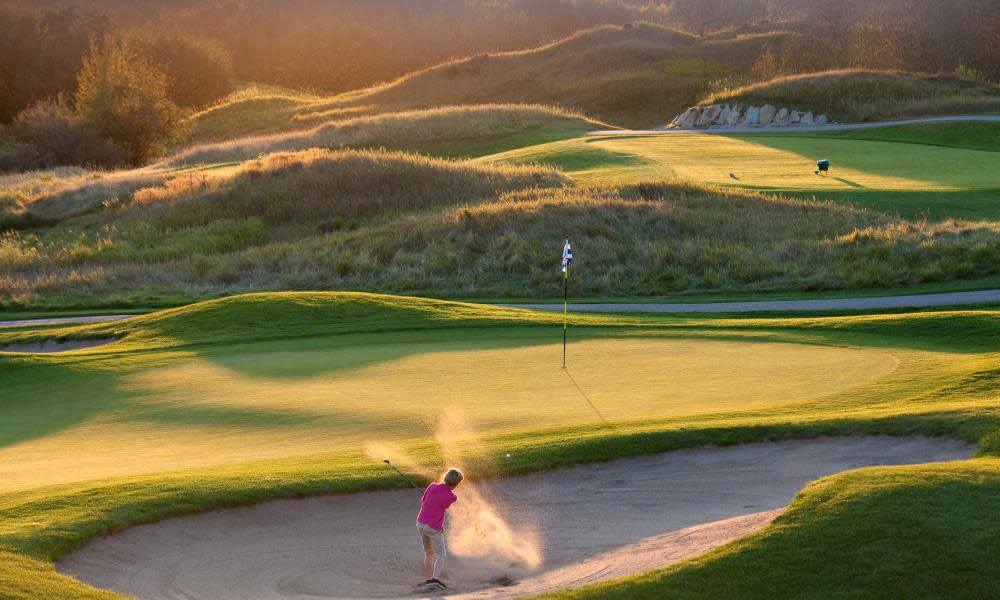Scottish golf’s biggest handicap? Its elitist clubs. But change is in the air...

It’s difficult to be good at golf when you have a swing like an industrial digger gouging trenches. When I was young, I tried so hard to be good at golf. However, my JCB technique was just one of a complex cocktail of technical challenges I faced when surveying the first hole before another wretched round.
Weekend golfers deploy a curious lexicon when describing the entrails of a bleak day out on the course. They talk regrettably about having a poor “touch around the greens”, but at least you have to reach the vicinity of the green to have a touch. Long before then, I’d conceded the hole while knee deep in heather. Others talked about “getting up and down in two”. My shots often went up but rarely came down within anyone’s range of visibility. My golfing phrase-book consisted of “fore”, “play through” and “I’ll just take another ball”. I developed a keen interest in the flora and fauna of streams and hedgerows. On an average round of golf I was a major threat to nesting field birds and soon took to leaving the others at the ninth hole and waiting for them in the clubhouse. If I hadn’t quickly renounced this game and all its empty promises, I’d have developed profound alcohol issues and the RSPB would have issued “Wanted” posters.
Perhaps if I’d been permitted to become a full member of a club, some of these problems could have been ironed out with the help of the professional, although this is doubtful. In Scotland in the 1980s, it was easier to get into the Long Room at Lord’s than to become a member of a decent club. Many seemed to pride themselves on having interminably long waiting lists and you were often told that if you were Catholic, Jewish or female you needn’t bother. In Glasgow, the Jewish community built their own course simply to guarantee membership.
Many clubs had arcane house rules and I was often asked to leave for breaking the strict dress code. This seemed to consist of dark blazers and light trousers, an unforgiving ensemble for sclerotic, middle-aged men when the soup began to spill and the visits to the gents grew more frequent.
There were professional reasons why women in particular faced widespread discrimination. Promotions and senior appointments in certain spheres of British industry weren’t gained by qualifications and a good interview: they were conferred in some Royal and Ancient redoubt after 18 holes and a bottle of Glenglaikit in these male-only environments. Brexit, the 2008 banking crisis and many miscarriages of justice involving police and the judiciary were probably spawned in these hideous places.
‘Brexit, the 2008 banking crisis and many miscarriages of justice involving police and the judiciary were probably spawned in these hideous places.’
Thus you are tempted to gloat at news of a crisis in Scotland’s golf clubs. This country has more than 5,750, an astonishing number for a country of barely five million people. In recent years, memberships have dwindled and clubs that were once proud of their exclusivity have taken to advertising cheap memberships in garish posters hung about their hallowed gates. This year, several clubs have faced closure, including two of the oldest in the west of Scotland.
Following a spate of closures six years ago, Hamish Grey, the then chief executive of the then Scottish Golf Union, now Scottish Golf, said: “What I’ve always felt is that you always have to look after the people who are your customers and maybe it was a case in golf when clubs had long waiting lists that they were too relaxed and didn’t feel as though they should be worried about the future.” This was a polite way of saying that many clubs facing closure were the authors of their own downfall. The decades of unchecked and widespread discrimination fostered a small-town sense of entitlement. Even as Scottish society began to change, these places seemed to provide a haven for old prejudices. “If fairness and equality are threatening your world then come here for comfort and reassurance,” they seemed to say.
However, the harrowing of Scotland’s club golf terrain may yet provide some welcome benefits for the country. No other sport or pastime offers exercise and relaxation in spectacular settings to so many people at every stage of their lives. If you live to be 90 you can derive joy from this game until your dying breath. It is a pillar of Scotland’s tourism industry and is too important to fail. Scottish Golf, which fosters the game at club level, has worked hard to recalibrate it and help clubs make the transition from the old models of presumptive negligence to something more flexible and sustainable. These changes have been too late for some clubs, but others that are well run and have embraced change may reap the benefit of new members from failing clubs.
Despite my many and varied failings at this game, both my sons have become tournament-winning scratch amateur golfers. They have different and more realistic perspectives. They feel that clubs are better structured and are much more friendly and welcoming to young people, including women and girls. Changing roles within families have also had an effect. The old model of a working man spending entire weekends on the golf course with his drinking chums is dying. Most clubs offer free memberships to juniors and equipment is much cheaper and can be hired.
Scotland always had too many golf clubs and when times were good they willingly associated themselves with insidious parochial prejudice and elitism. Few will mourn the passing of some. Golf will continue to thrive in Scotland, but now this might include those clubs whose parents were once told they weren’t welcome.
• Kevin McKenna is an Observer columnist

 Yahoo News
Yahoo News 
